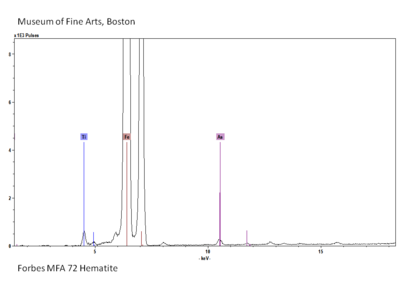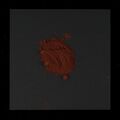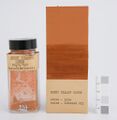Difference between revisions of "Category:Iron Oxide Red: Ukiyo-e colorant"
(Created page with " File:SC130566.jpg|right|250px|link=https://collections.mfa.org/objects/234428/under-the-wave-off-kanagawa-kanagawaoki-namiura-also-kn?ctx=ed6b9b8b-e830-4c25-9793-ba76460591...") |
|||
| (32 intermediate revisions by the same user not shown) | |||
| Line 1: | Line 1: | ||
| − | [[File: | + | [[File:SC129706.jpg|right|300px|link=Hiroshige I, Naitô Shinjuku, Yotsuya, from the series One Hundred Famous Views of Edo, 11.35823|Naitô Shinjuku, Yotsuya, from the series One Hundred Famous Views of Edo by Utagawa Hiroshige I]] |
| − | <font size="3">'''[[Hematite]]'''</font> 弁柄(''bengara''): | + | <font size="3">'''[[Hematite|Iron oxide red]]'''</font> 弁柄 (''bengara''): A natural colorant derived from hematite, a metallic black-gray or dark red mineral primarily composed of [[ferric oxide|iron oxide]] or from [[Red ocher|red ochre]], an earth pigment containing hematite, clay, and silica. Red ochre can also be made by roasting yellow ochre. While the type of iron oxide red used in ''ukiyo-e'' prints has not been identified, the most likely source is an artificially made iron oxide red. During the Edo period (1603–1868), ''rōha bengara'' (ローハベンガラ) and ''tettan bengara'' (鉄丹ベンガラ) were manufactured. ''Rōha bengara'' was made by roasting [[melanterite]] (rōha or ryokuban 緑礬), an iron sulphate that naturally forms or is artificially produced from an iron sulphide byproduct of copper mining. After the roasting process, it was crushed and levigated to produce fine particles of iron oxide red. Manufactured in Fukiya, it appears to have dominated the market and is known to have been used in porcelain, such as Arita ware and lacquerware. ''Tettan bengara'' was made from burning rusted iron scraps and was considered to be of lesser quality than ''rōha bengara''. |
| − | + | Iron oxide red has been the most commonly found brown whether used alone or in mixtures. When printed, it appears dense and opaque. Iron oxide red has been found on early hand-colored to full color prints throughout the Edo period. The color can range from a bright light red to a deep almost maroon brown. | |
| − | '''For | + | '''For additional information see:''' [[Hematite]], [[Ferric oxide]], [[Red ochre]] |
| + | <br> | ||
<br> | <br> | ||
| − | == Examples of | + | == Examples of Iron oxide red in Ukiyo-e Prints == |
{|class="wikitable" style="display: inline-table;font-size:90%;text-align:center;width:15%" | {|class="wikitable" style="display: inline-table;font-size:90%;text-align:center;width:15%" | ||
| Line 43: | Line 44: | ||
== Analysis == | == Analysis == | ||
| − | X-ray fluorescence analysis (XRF) is used to detect iron, | + | X-ray fluorescence analysis (XRF) is used to detect iron (Fe). When it is found in a red/brown area, it is an indication for the presence of iron oxide red (Fe<sub>2</sub>O<sub>3</sub>). |
| + | |||
<gallery mode="packed" heights="200px" style="text-align:left;"> | <gallery mode="packed" heights="200px" style="text-align:left;"> | ||
| − | + | Slide8_FC72.PNG|<center>XRF spectrum of Iron oxide red</center> | |
</gallery> | </gallery> | ||
| − | == | + | ==Images of Iron oxide red== |
<gallery> | <gallery> | ||
File:Hematiteemr1.jpg|Hematite | File:Hematiteemr1.jpg|Hematite | ||
File:Hematiteemr2.jpg|Hematite | File:Hematiteemr2.jpg|Hematite | ||
File:6869 hematite_2up.jpg|Hematite | File:6869 hematite_2up.jpg|Hematite | ||
| − | File: | + | File:120 iron oxide red.jpg|Ferric oxide |
| − | File: | + | File:23_Red_ocher_200X.jpg|Red ocher |
| − | File: | + | File:Ironoxidered.jpg|Iron oxide red |
| − | File: | + | File:Printed bengara-cropped.jpg|Printed iron oxide red |
| + | File:NMAH-AHB2017q005548.jpg|Red ochre, <small>by National Museum of American History</small>|link=https://americanhistory.si.edu/collections/nmah_1323748 | ||
| + | File:S2pXfCsMudQ-SD.jpg|Future of bengara (video), <small>by Science Channel (JST)</small>|link=https://youtu.be/s2pXfCsMudQ?si=mL-3R4O4ZpGFDRCz&t=42 | ||
| + | File:20464300.jpg|Ochres (audio), <small>by Harvard Art Museums</small>|link=https://harvardartmuseums.org/tour/660/slide/11172 | ||
</gallery> | </gallery> | ||
==List of Prints == | ==List of Prints == | ||
| − | + | Below is a list of prints where iron oxide red was detected. | |
| − | |||
| − | |||
| − | |||
Latest revision as of 03:07, 22 April 2024
Iron oxide red 弁柄 (bengara): A natural colorant derived from hematite, a metallic black-gray or dark red mineral primarily composed of iron oxide or from red ochre, an earth pigment containing hematite, clay, and silica. Red ochre can also be made by roasting yellow ochre. While the type of iron oxide red used in ukiyo-e prints has not been identified, the most likely source is an artificially made iron oxide red. During the Edo period (1603–1868), rōha bengara (ローハベンガラ) and tettan bengara (鉄丹ベンガラ) were manufactured. Rōha bengara was made by roasting Melanterite (rōha or ryokuban 緑礬), an iron sulphate that naturally forms or is artificially produced from an iron sulphide byproduct of copper mining. After the roasting process, it was crushed and levigated to produce fine particles of iron oxide red. Manufactured in Fukiya, it appears to have dominated the market and is known to have been used in porcelain, such as Arita ware and lacquerware. Tettan bengara was made from burning rusted iron scraps and was considered to be of lesser quality than rōha bengara.
Iron oxide red has been the most commonly found brown whether used alone or in mixtures. When printed, it appears dense and opaque. Iron oxide red has been found on early hand-colored to full color prints throughout the Edo period. The color can range from a bright light red to a deep almost maroon brown.
For additional information see: Hematite, Ferric oxide, Red ochre
Examples of Iron oxide red in Ukiyo-e Prints

|

|

|

|

|
Analysis
X-ray fluorescence analysis (XRF) is used to detect iron (Fe). When it is found in a red/brown area, it is an indication for the presence of iron oxide red (Fe2O3).
Images of Iron oxide red
List of Prints
Below is a list of prints where iron oxide red was detected.
Pages in category "Iron Oxide Red: Ukiyo-e colorant"
The following 11 pages are in this category, out of 11 total.












